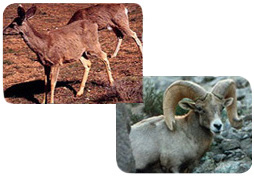Phoenix Area Office - Programs & Activities
Environmental Resource Management
Protecting the Natural Environment
DEER AND BIGHORN SHEEP

 In planning the CAP, Reclamation realized that many desert animals would be attracted to the canal for water, particularly
during the hot, dry months. In an effort to reduce animals drowning in the concrete-lined canal Reclamation
funded a six - year study by the University of Arizona and a three year study by the Arizona Game and Fish
Department to identify ways of protecting wildlife along the canal route. As a result of these studies:
In planning the CAP, Reclamation realized that many desert animals would be attracted to the canal for water, particularly
during the hot, dry months. In an effort to reduce animals drowning in the concrete-lined canal Reclamation
funded a six - year study by the University of Arizona and a three year study by the Arizona Game and Fish
Department to identify ways of protecting wildlife along the canal route. As a result of these studies:
Eight foot high fences have been constructed on both sides of the canal for more than 90% of the aqueduct's length to keep desert mule deer, bighorn sheep, javelina, and other large animals out of it. The top five feet of the concrete lining has a rough finish that allows the smaller animals that can get through the fence to climb down to the water for a drink and then climb safely back out.
Ramps have been constructed in small distribution canals so wildlife can escape if they slip in while drinking.
Potentially important movement paths intersected by the canal were identified by radio-tracking collared animals, and specially-designed bridges were placed at these locations so animals could safely cross the canal. Drainage structures along the canal were modified for animal use. Underpasses were built on new roads in key movement areas so deer and other wildlife could avoid vehicular traffic. Funding was provided to the Arizona Game and Fish Department, Bureau of Land Management, Forest Service, National Park Service, and Pima County for construction of 45 wildlife watering developments located away from the CAP canal and new roads. To further reduce animal losses in the canal, student biologists were employed during the summer to patrol the aqueduct and rescue any deer or other animals that entered it. Occasional vandalism or erosion under the fence can allow access to the canal by wildlife.
An important deer movement corridor between the Tucson Mountains and the Roskruge Mountains across the Tohono O'odham Nation west of Tucson also crosses the CAP canal. To minimize disruption to deer movements and other wildlife in this unique area and to preserve this corridor, Reclamation buried parts of the canal under six washes and purchased 4.25 square miles of desert habitat. The Tucson Mitigation Corridor is managed by Pima County as part of the Tucson Mountain Park system and will be protected from future development.
[ Reclamation and the Fossil Creek Fish Barriers ]
[ Bald Eagles ]
[ Deer and Bighorn Sheep ]
[ CAP Mitigation History ]
[ Riparian Vegetation ] [ Desert Tortoises ] [ Desert Vegetation ] [ Rare Plants ]
[ Riparian Vegetation ] [ Desert Tortoises ] [ Desert Vegetation ] [ Rare Plants ]

